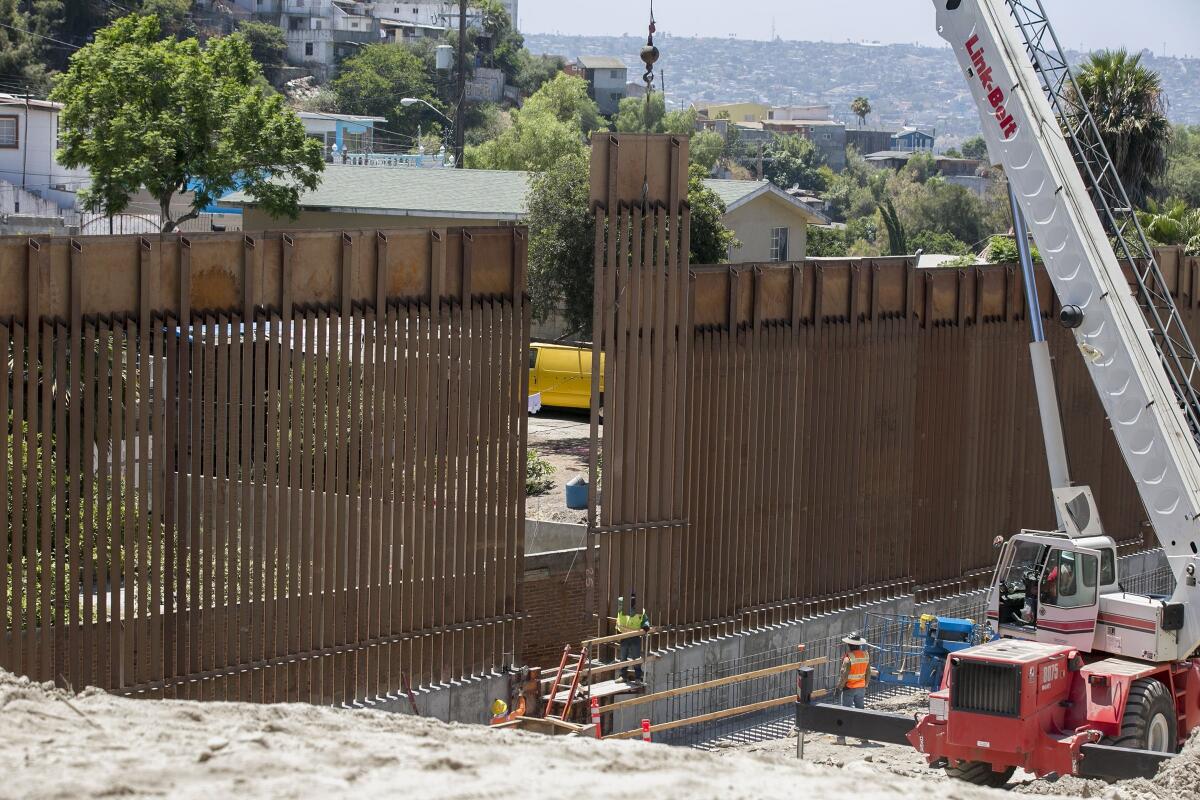Three years in, Trump is still pushing his crazy border wall

- Share via
From the earliest days of his campaign to become president, Donald Trump seized on the construction of a “beautiful” wall along the U.S.-Mexico border as a solution to what he asserted was the dangerous and costly problem of illegal immigration.
The wall, which became a rallying cry for his supporters, stood as a symbol of Trump’s resolve to take action where he said others had failed and to significantly alter how the U.S. handles immigration. It told the world in the clearest possible imagery that, under President Trump, a nation founded on immigration would no longer be so welcoming to outsiders.
In the four years since, however, Trump’s multibillion-dollar white elephant of a campaign promise has been dogged by all manner of challenges and setbacks. The most recent is a decision this week by the Pentagon’s inspector general to investigate how a North Dakota construction firm, which critics say did not meet the bid standards, won a $400-million U.S. Army Corps of Engineers contract to build 31 miles of the wall in the Cabeza Prieta National Wildlife Refuge in southern Arizona. It’s probably no coincidence that the contract was awarded after heavy lobbying by Trump on behalf of Fisher Sand and Gravel, whose owner, Tommy Fisher, has been a vocal and generous backer of the president and his immigration enforcement policies.
Fisher also is involved in another border wall imbroglio. His company, working with We Build the Wall, an anti-immigration nonprofit, bought private property in south Texas on which it planned to build 3.1 miles of border fencing. That project has been hit with two court injunctions over charges that the wall builders had not received the necessary permits to do the work in an environmentally sensitive area. Ironically, one of the legal challenges was filed by the U.S. Justice Department on behalf of the International Boundary and Water Commission — a joint U.S.-Mexico entity overseeing the Rio Grande — which argues that the builders failed to submit sufficient studies about the wall’s impact on flooding. So yes, the Trump administration is suing one of Trump’s favorite backers working on one of Trump’s favorite projects. We can just imagine the president sputtering over his Twitter keyboard.
Separately, a state court also blocked the project after a legal challenge by the National Butterfly Center over the wall’s potential degradation of the insects’ habitat.
Those recent controversies are a reminder that, fortunately, Trump has made little headway on the wall. Congress has refused most of his funding requests, which led Trump to declare a national emergency where none exists to use tax dollars to build the wall anyway. While the Supreme Court has lifted an injunction (although the lawsuit continues) against Trump’s plan to shift $2.5 billion in Defense Department anti-drug trafficking funds to border construction, lower courts halted his efforts to shift an additional $3.6 billion allocated for military construction projects to build the wall.
None of those lawsuits, by the way, address the fundamental issue of whether a wall will do much to limit illegal immigration, which seems unlikely, given that walls are readily breached and that most people living illegally in this country came in with valid visas but never left.
As it is, the administration didn’t begin construction of any wall or fencing where none previously existed until this fall, and even then it built only an eight-mile segment in Texas. Although the government has managed to erect a total of about 93 miles of new fencing, nearly all of it updates or replaces existing barriers. Still, the administration is pressing forward with what seems like desperation to build up to 500 miles of new wall by the end of 2020, which means the wall will probably, once again, be a major campaign issue in the coming year.
Trump won election in 2016 by exploiting racial and social differences, demonizing outsiders and tapping into a disquieting national undercurrent of class and political resentment. No one should look forward to a repeat of that toxicity. Trump’s strategy of seeking to lead the United States by dividing it has exposed a darkness in our national politics. It doesn’t take handwriting on a wall to understand how dangerous, and counterproductive, that can be.
More to Read
A cure for the common opinion
Get thought-provoking perspectives with our weekly newsletter.
You may occasionally receive promotional content from the Los Angeles Times.









